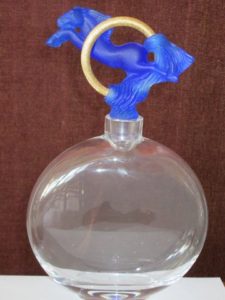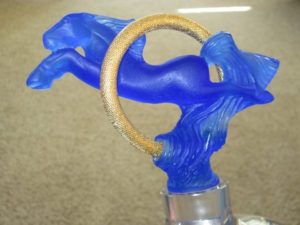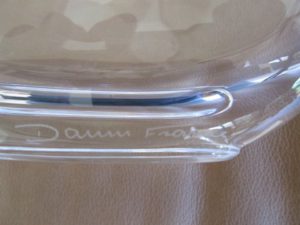 GD showed me a simply fabulous Daum Nancy colorless glass decanter from France, made in the early 20th century. Created in the Art Deco style, we see a frosted glass horse jumping through a brass ring atop the stopper. The fine clear crystal round bottle is signed “Daum Nancy” towards the foot. The studio originally presented the decanter in a Daum box. The piece is about 12” high.
GD showed me a simply fabulous Daum Nancy colorless glass decanter from France, made in the early 20th century. Created in the Art Deco style, we see a frosted glass horse jumping through a brass ring atop the stopper. The fine clear crystal round bottle is signed “Daum Nancy” towards the foot. The studio originally presented the decanter in a Daum box. The piece is about 12” high.
The remarkable history of Daum began in 1878. Founded by Jean Daum and his two sons, Auguste and Antonin, the factory ushered in the great French Art Nouveau period. Daum glass defined the period, so much so that the groundbreaking Paris Universal Exhibition of 1900 gave Daum glass a “Grand Prix” medal.
Daum factory premiered four unique processes in glass:
- Direct carving upon glass,
- Enameling (painting) on glass
- Engraving (sometimes done with acid) on glass.
GD’s decanter exhibits a later novel technique (1906), featured on the stopper, called pate de verre. This gives the effect of frosted glass. Bits of glass and crystal are forced into a mold and are heated to create a figure in a kiln.
Art Nouveau Daum glass became very collectible and expensive, and often reproduced today. In fact, and sadly, forgers most notably fake Daum glass in Eastern Europe.
 Forgers don’t find it hard to reproduce “cameo” glass, which is reductive, a “cut away” technique. A vessel of glass is blown with one color of glass, then the glass blower coats this vessel with a re-blown color application of glass. If the vessel doesn’t break, the two colors of glass fuse together. Next, an expert cutter trims into the outside layer of color, creating a cameo effect when the light hits the vessel. This can be done with a hand tool, a true Daum process. In the case of reproductions, forgers might achieve this cut away with an acid that eats away, quite savagely, a specific area of glass.
Forgers don’t find it hard to reproduce “cameo” glass, which is reductive, a “cut away” technique. A vessel of glass is blown with one color of glass, then the glass blower coats this vessel with a re-blown color application of glass. If the vessel doesn’t break, the two colors of glass fuse together. Next, an expert cutter trims into the outside layer of color, creating a cameo effect when the light hits the vessel. This can be done with a hand tool, a true Daum process. In the case of reproductions, forgers might achieve this cut away with an acid that eats away, quite savagely, a specific area of glass.
How do you tell if your Art Nouveau piece is Daum?
Look at the quality of the cut. A real Daum piece will have a cut edge that gradually descends into the second color at an angle. In reproduction pieces, the cut appears straight and abrupt, an oblique cut that doesn’t allow for that delightful change of color as the light plays upon the vessel. As always, finesse is everything.
To this day Daum is the only factory that uses the pate de verre (glass paste) process. We see the unique stopper made in a figural horse in this decanter. Due to this elegant process, when light shines through it, the piece glows. Daum premiered the use of this “half way” transparent glass in specific panels in stained glass windows.
Daum didn’t discover this process.
The Egyptians knew pate de verre, and their technique was followed by the Roman glassmakers. They buried the glass in the sand, where the minerals in the sand naturally frosted the glass, after they fused bits of glass together in a kiln.
The pate de verre horse fused around a piece of metal makes GD’s decanter particularly unique, and almost impossible to manufacture. The two elements tend to heat at such different temperatures. Daum keeps how they did this a secret.
If you want to know more about the secrets of glass making
Get out your passport and book a flight to the French city of Nancy, the home of Daum. You’ll visit the Museum of Fine Arts of Nancy (Musee des Beaux-Arts) where you’ll see the history of glass 1880-1990’s. Save a little money to buy a piece of Daum at the Place Stanislas in Nancy.
 By the way, those collectors who collect Daum also collect Galle glass. Galle glass is also faked in Eastern European sweatshops). GD’s decanter form was originally made with a series of stoppers, picturing OTHER animals. One with a jumping monkey, holding that gilt bronze ring, sold at Garth’s Auction for $800. One of the most collectible areas of the glass world, Art Deco glass surpasses today the value achieved by Art Nouveau glass. And GD’s is NOT a fake, but the real thing. Fraudulent copies DO have a faked signature, but GD’s is NOT. What a treasure and definitely a keeper. If GD had the original box, we’d say $1,000.
By the way, those collectors who collect Daum also collect Galle glass. Galle glass is also faked in Eastern European sweatshops). GD’s decanter form was originally made with a series of stoppers, picturing OTHER animals. One with a jumping monkey, holding that gilt bronze ring, sold at Garth’s Auction for $800. One of the most collectible areas of the glass world, Art Deco glass surpasses today the value achieved by Art Nouveau glass. And GD’s is NOT a fake, but the real thing. Fraudulent copies DO have a faked signature, but GD’s is NOT. What a treasure and definitely a keeper. If GD had the original box, we’d say $1,000.
Pingback: Rene Lalique Blurred the Line Between Nouveau and Deco - Elizabeth Appraisals